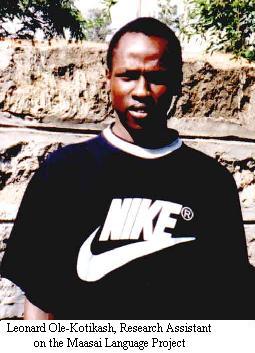
© Doris L. Payne 2008
The following links lead to a brief description of the
Maa language. The Maa language or language group has several varieties, all known as "Maa". It is spoken by approximately 500,000 Maasai, Samburu,
Camus in Kenya, and about 500,000 Arusa, Kisonko and IlParakuyo people in Tanzania.
The variety described in the following pages corresponds to southern Kenyan Maasai.

1. Introduction: The Maa Language vs. Maasai Ethnicity
2. The Nilo-Saharan Language Family (Historical Linguistics)
3. The Sounds of Maa (Phonology)
4. Maa Vowels (or, "What do Tongue Root Contrasts Sound Like?")
5. Maa Words (Morphology)
6. Maa morphology puzzle (Gender)7. Maa Sentences (Syntax)
8. Semantic Domains: Color Terms
9. Language Change and Borrowings
Brenzinger, Matthias. 1992. Lexical retention in language shift: Yaaku/Mukogodo-Maasai and Elmolo/Elmolo-Samburu. In Matthias Brenzinger (ed.) Language Death: Factual and Theoretical Explorations with Special Reference to East Africa, 213-254. Berlin: Mouton de Gruyter.
Dimmendaal, Gerrit. 1992. Reduction in Kore reconsidered. In Matthias Brenzinger (ed.) Language Death: Factual and Theoretical Explorations with Special Reference to East Africa, 117-135. Berlin: Mouton de Gruyter.
Greenberg, Joseph. 1963. The Languages of Africa. Bloomington: Indiana University Press.
Hamaya, Mitsuyo. 1993. Maasai Auxiliaries and Infinitival Constructions. University of Oregon Masters Thesis.
Heine, Bernd. 1981. Lorkoti Dorobo, a Maasai dialect. In I. Hofmann (ed.), Festschrift zum 60 Geburtstag von P. Anton Vorbichleri, 31-46. (Veröffentlichungen der Institute für Afrikanistik und Agyptologie der Universität Wien 14.) Wien: Beiträge zur Afrikanistik.
Heine, Bernd and Matthias Brenzinger. 1988. Notes on the mukogodo dialect of Maasai (Kenya). Afrikanistische Arbeitspapiere 14.97-131.
Heine, Bernd and Ulrike Claudi. 1986. On the Rise of Grammatical Categories: Some Examples from Maa. Berlin: Dietrich Reimer Verlag.
Levergood, Barbara. 1987. Topics in Arusa Phonology and Morphology. University of Texas at Austin Ph.D. dissertatin.
Mol, Fr. Frans. 1972. Maa: A Dictionary of the Maasai Language and Folklore, English-Maasai. Nairobi: Marketing and Publishing Ltd.
Mol, Fr. Frans. 1996. Maasai Language and Culture Dictionary. Lemek, Kenya: Maasai Centre Lemek.
Payne, Doris. 1997. The Maasai External Possessor construction. Essays on Language Function and Language Type, ed. by Joan Bybee, John Haiman and Sandra Thompson, 395-422. Amsterdam: John Benjamins.
Payne, Doris. 1998. Maasai gender in typological perspective. Studies in African Linguistics 27.159-175.
Payne, Doris, Mitsuyo Hamaya and Peter Jacobs. 1994. Active, passive, and inverse in Maasai. Voice and Inversion, ed. by T. Givón, 283-315. Amsterdam: John Benjamins.
Tucker, A. N. and J. tompo Ole Mpaayei. 1955. A Maasai Grammar with Vocabulary. London: Longmans, Green and Company.
Vossen, Rainer. 1988. Towards a Comparative Study of the Maa Dialects of Kenya and Tanzania. (Nilo-Saharan 2.) Hamburg: Helmut Buske.
Wallace, B. F. 1981. The morphophonemics of the Maasai verb. Nilo-Saharan: Proceedings of the First Nilo-Saharan Linguistics Colloquium, Leiden, September 8-10, 1980. Ed. by Thilo Schedeberg and M. Lionel Bender, 75-88. Dordrecht: Foris.
Winter, J. C. 1979. Language shift among the Aasáx,
a hunter-gratherer tribe in Tanzania. Sprache und Geschichte in Afrika
1:175-204.